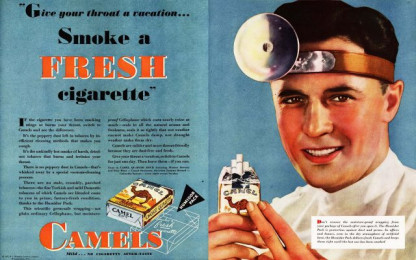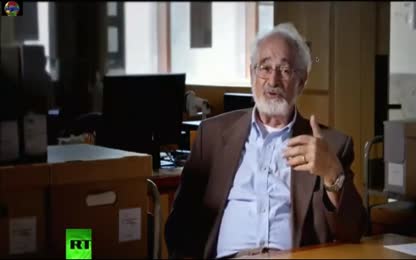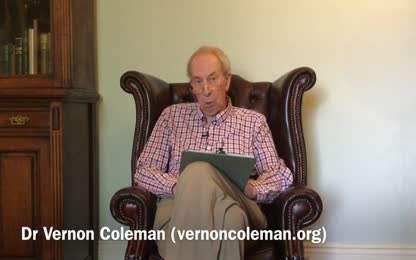Advertisement
Ignorance and Prejudice in Medicine
Ignorance and Prejudice in Medicine
Dr Vernon Coleman looks at how the medical establishment has, for centuries, promoted bad medical practices and suppressed original ideas that would help patients.
For more unbiased information about other important matters, please visit https://www.vernoncoleman.com
Dr Coleman’s book on medical history is called, ’The Story of Medicine’ which is available on Amazon.
- Category: Big Pharma /FDA Approved /CDC,Government Experiment,Health Concerns
- Duration: 18:05
- Date: 2021-06-10 19:49:46
- Tags: no-tag
3 Comments
Video Transcript:
Over the years, the medical establishment has acquired a well-deserved reputation for ignoring good discoveries, which would make a dramatic difference to human health and continuing with useless practices which do more harm than good, long after they should have abandoned them. The medical profession, or rather I should say the medical establishment has always been slow to accept and assimilate new ideas and slow to see the obvious. I've long thought that the main problem with modern medical education is that it's largely based upon learning by rote and upon eliminating all original thought. This is deliberate since the aim of an orthodox, modern medical education is to help maintain the status quo and preserve the position of the pharmaceutical industry. Right from the very beginning, young students are made to learn long lists of information. They learn the names of the bones, the arteries, and herbs and the veins in the body. They learn the names of the muscles and they learn a histology of the various organs, they then learn lists of clinical signs and symptoms, and they learn lists of drugs at no point a student's encouraged to think for themselves. As a result, it's not surprising that after graduation most doctors continue to do as they are told. The average doctor is strangely incapable of critical thought. Given the indoctrination they've undergone, it's hardly surprising that doctors readily accept everything they're told by the drug companies, which more or less control postgraduate education, and equally readily reject alternative medicine, something which never makes much of an appearance in the undergraduate syllabus. There's nothing new about this. The greatest thinkers, the ones who have in the end contributed most to medicine and human health have always been scorned or ignored, or preferably both, by the medical establishment. The establishment has always maintained the truth to suit its own political religious or commercial purposes, simple truths which are inconvenient have always been suppressed. It happened in the past, and it will happen in the future, and it's happening now. Few medical stories illustrate the way the medical establishment works better than the story of how scurvy was discovered and how the treatment for it was ignored for centuries. In 1535, Jakarta sailed from France to New Fandland with a crew of 110 men. Within six weeks, a hundred of his men had developed scurvy. Lucky, luckily for Cartier and his men, a native told them to drink the juice from the fruit of one of the local trees, the men we covered in days. From that time on, wise sea captains made sure that their men were given regular supplies of orange or lemon juice. In a book called The Surgeon's Mate published in 1636, John Woodall recommended that these juices be used to prevent scurvy, but the medical establishment was slow to accept this sensible suggestion. It wasn't until two centuries after Cartier in 1747 that the idea was reintroduced by James Lind, who conducted a proper clinical trial and proved that scurvy could be prevented with the right diet. It was Lind's work, which enabled Captain Cook, and it was left tenant at the time. So around the world, without a single case, of scurvy. But the admiralty and the medical establishment continued to ignore this in the seven years' war from 1756 to 1763, approximately half of the 185,000 sailors involved died of scurvy. In 1779, the channel fleet had 2,400 cases of scurvy after a single ten-week cruise. Eventually, in 1795, the medical establishment and the navy succumbed to common sense, and lemon juice became a compulsory part of every sailor's diet. This breakthrough had taken well over two centuries to be accepted. Then there's Paracelsus. There's no doubt that Paracelsus, a realist, theophrastus bombastus von Hovenheim to his friends, is a father of modern medicine. He tore into the precepts of established medical thinking with all the zeal of a missionary. He revolutionized medical thinking throughout Europe and scandalized the medical establishment by claiming to have learned more from his contact with witches and midwives than from his study of ancient and well-reveared medical texts. No idea or theory was too bizarre to be studied and considered a no-belief, no practice, and no concept, too sacred to be rejected. He was the first man to associate mining with chest disease, to use mercury and the treatment of syphilis to advocate allowing wounds to drain instead of smothering them with layers of dried dung, and to argue that some foods contained poisons which harm the human body. Paracelsus scandalized the establishment by claiming that he was interested more in pleasing the sick than his own profession. He was not surprisingly rejected by the medical establishment and widely and persistently persecuted for his beliefs. It was years after his death, that his ideas were recognised, and then there's Vesalius. In the 16th century Andreas Vesalius achieved contemporary notoriety and eternal fame as the author of the first textbook of human anatomy. Up until Vesalius medical students had studied anatomy using text prepared by Galen, since Galen used pigs, not human corpses for his studies, his anatomical notes were, to say the least, rather misleading. Vesalius' frank rejection of many of Galen's anatomical claims earned him considerable disapproval. The medical establishment still firmly believed that Galen could do no wrong. They weren't interested in anything as superficial and irrelevant as evidence. Like so many original thinkers before and after him, Vesalius was unable to cope with the outcry. He burned his remaining manuscripts, abandoned his study of anatomy, and took a job as court physician to Charles V. Madrid. Vesalius wasn't the only anatomist whose work was rejected. In the 17th century British doctor William Harvey spent eight years researching the circulation of the blood and getting it right. His patients was rewarded with ridicule. He received nothing but abuse. He lost many friends and his practice shrank. When Ambrose Parre, the great French surgeon, first started work as an army surgeon, it was accepted practice to stop a hemorrhage by sealing a wound with a red-hot iron. Amputations were performed with a red-hot knife and the wounds which were left were sealed with boiling oil. One day Parre ran out of boiling oil and used a mild emollient to dress the wounds of the men. He was treating. He worried all night about what he'd done, but the next day he found that his patients were not only healthy, but that they were also in less pain than the men whose wounds had been sealed with boiling oil. Parre was wise enough to learn from this, and from that day on he started dressing wounds with an emollient rather than boiling oil. He also introduced ligatures, artificial limbs and many surgical instruments. Inevitably, Parre met the usual fate of innovators and reformers who get a rougher ride within the world of medicine than anywhere else. He was denounced by other surgeons as dangerous and unprofessional. Older surgeons banded together to oppose him, and in their attempts to discredit him, they attacked him for all sorts of things. For example, his ignorance of Latin and Greek. Parre eventually succeeded because the soldiers he treated trusted him and wanted to be treated by him. They weren't interested in the views of the French medical establishment. A look back at hospitals is also revealing when Sa Paul came to par in Russia in 1796. He was so horrified at the state of the hospital in Moscow that he ordered it to be rebuilt. In Frankfurt, in the 18th century physicians considered working in hospital to be the equivalents of a sentence of death. In 1788, Jacquesbus Rénait-Tennon published a report on the hospitals of Paris which shopped city officials. He described how the hotel dear for the magnificent looking hospital still there next to Notre Dame contained twelve hundred beds but up to seven thousand patients. With up to six patients crammed into each bed, the stench in the hospital was so foul that people who entered would do so holding a vinegar so sponge to their noses. Very few patients escaped from the hospital with their lives. When reformer John Howard toured European hospitals, he angrily reported that no fresh air, no sunlight, straws bedding, no bandages, and a milk and water diet supplemented with weak soup were standard. The reports of Tennon and Howard were ignored and dismissed for years and it took decades for the medical establishment to make any real changes. In the 18th century, the treatment of the mental ill was abysmal. Daniel DeFoe, best remembered for his story of the adventures of Robinson Crusoe, wrote a vicious attack on mental hospitals. "'Is it not enough to make anyone mad?' he asked, to be suddenly clapped up, stripped, ill-fed and worst, to have no reason to sign for such treatment, no crime alleged or accuses to confront, and what is worse, no soul to appeal to, but merciless creatures who answer but in laughter, silliness, contradiction and too often stripes. No one took much notice and medical practitioners continued to treat mentally ill patients without respect or care. At the Bethlehem, Royal Hospital, half-naked patients were kept chained in ions, physicians bled their patients once a year, and the more troublesome patients were put on a tranquilising wheel, until 1770 visitors could pay a penny to see the fun at Bethlehem. John Wesley found, with the Wesleyan church, he considered himself a benefactor of the mental ill, suggested pouring water onto the heads of the mental ill and forcing them to eat nothing but apples for a month. Wesley was one of the first men to use electricity in the attempted treatment of the mental ill. Despite the protests of reformers who shocked the establishment in the late 18th century by claiming that the mentally ill were sick and needed treatment, mental hospitals were well into the 19th century, still quite unsuitable for people who were ill and needed treatment. There was never any evidence to show that it did any good, but bloodletting was a favourite therapeutic tool for centuries. The fact that removing blood from a patient made him or her quieter was regarded as proof that it was doing some good. This is no doubt of the rational used to explain some modern treatments. Bloodletting was easy to perform and it was something to do. Doctors have always felt the need to do something to their patients, possibly, because it's difficult to explain away a big fee is of all you do is talk. Leaches were hugely popular in the 19th century. In 1824, two million leaches were imported into France. In 1832, the figure had risen to 57 million a year. In 1843, the American poet, novelist and anatomist Oliver Wendell Holmes, read to the Boston Society for Medical Improvement, a paper entitled, on the contagiousness of purple fever. He argued that the disease could be carried from patient to patient by doctors. He suggested that surgeons should consider changing their clothes and washing their hands after leaving a patient with purple fever. His lecture annoyed the medical establishment and his advice was ignored completely. A similar fate befell Ignat's Philip Semmelvice, who in 1846 at the age of 28, became an assistant in an obstetric ward at the hospital in Vienna. Semmelvice noticed that the number of women dying in his ward was higher than the number dying in other wards. It wasn't difficult to notice this. Women would beg in tears, not to be taken into Semmelvice's ward. Deciding that he wasn't that bad a doctor, Semmelvice looked for an explanation and came to the conclusion that the major difference was that patients on his ward were looked after by medical students, whereas the patients on other wards were looked after by midwives. Semmelvice then discovered that the students came straight to the ward from the dissecting room where they'd had their hands stuck into the corpses of women who died from purple fever. The midwives never went near the dissecting room. Semmelvice instructed the medical students that they should start washing their hands in a solution of calcium chloride after coming from the dissecting room. The remedy produced a dramatic drop in the death rate on his ward. Predictably, however, the medical establishment was not well pleased, even though Semmelvice had proved his point very dramatically. The unfortunate young doctor couldn't cope with the rejection he became an outcast and died in a mental hospital a few years later. The medical establishment had scored another hollow victory. Once again, patients with a loses. You might have thought that the medical establishment would have welcomed anesthesia. After all, before anesthetics were available, surgeons had to get their patients drunk or knock them out with a blow to the head. Surgeons would often operate with the patient held down by four strong men. The first operation under anesthesia was performed at the Massachusetts General Hospital in 1846, but the establishment was not going to accept this newfangled nonsense lying down. The main objection was that anesthetics were being used to help women who were in labor, and that said the establishment just wasn't acceptable. It was, said the wise men, unnatural and unhealthy for women to deliver babies without suffering pain. In sorrow, the shell bring forth children, says the Bible. However, the religious barbarians were eventually overcome by Dr. James Simpson, who trumped the Bible quotas with this quote, and the good Lord caused a deep sleep to fall upon Adam, and he slept, and he took one of his ribs and closed up the flesh instead thereof. The opposition to anesthesia was finally quelled only when Queen Victoria gave birth to Prince Leopold while under the influence of chloroform. In 1867, Joseph Lister published a paper in the Lancet entitled, on the antiseptic principle in the practice of medicine. Lister had found a solution to the age-old problem of post-operative infection, but the medical establishment doesn't like change even if it means keeping patients alive and Lister found himself attacked by doctors who ignored the evidence but disapproved of his new techniques, simply because they were new. It was decades before the antiseptic principle was accepted. One of the reasons why hospital infections are so common today is that doctors and nurses seem to believe that they can use antibiotics instead of washing their hands. Incompetent, carelessness and ignorance mean that the quality of cleanliness in the average modern hospital is often a little better than it was in a hospital in the Middle Ages. Until surprisingly recently, it was routine for surgery on babies to be performed without anesthesia on the grounds that babies were incapable of feeling pain. There was no evidence for this claim. One which any mother would be able to oppose with credible if anecdotal evidence, but anithetists were taught that babies had immuid, immature, nervous systems, and so didn't need painkillers. I have so far described just a few of the hundreds, probably thousands of examples I could give to illustrate the way that the medical establishment allied with the early, middle and later pharmaceutical industry has always opposed original thought and has protected the status quo regardless of the effect on patients. The medical establishment, as I'm afraid, acted in the interests of the profession but against the interests of patients, unthoughtful and creative individuals have always had a hard time. The value of serendipity has also been ignored, of course, both penicillin and x-rays with a result of serendipity. The real tragedy in all this is that absolutely nothing has changed for the better. Indeed, things have arguably got worse. The medical establishment is still responsible for protecting and promoting medical procedures which don't work and have never worked, and which expose patients to great risk, while at the same time it opposes and suppresses treatments which do work and have been proved to work. Today, anyone in the medical profession who dares to offer thoughts or warnings which don't fit in with the specific requirements of the medical establishment will get the semi-vice treatment. They'll be laughed out and suppressed and demonized. Nothing's changed, as I and others have discovered to our cost. Thank you for watching an old man in a chair. Please visit vernacommon.org for more videos and articles.











 Donate
Donate







